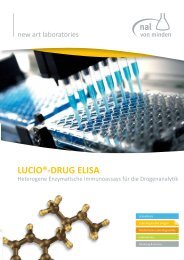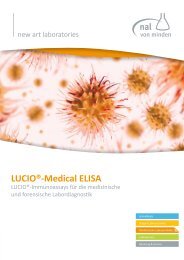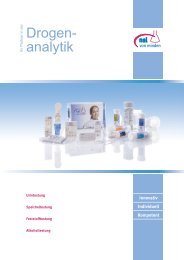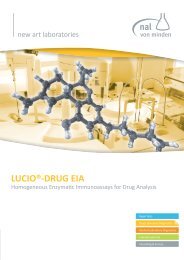LUCIO®-Medical ELISA Brochure - nal von minden
LUCIO®-Medical ELISA Brochure - nal von minden
LUCIO®-Medical ELISA Brochure - nal von minden
You also want an ePaper? Increase the reach of your titles
YUMPU automatically turns print PDFs into web optimized ePapers that Google loves.
Test Principle<br />
Our <strong>LUCIO®</strong>-<strong>Medical</strong> and Sero <strong>ELISA</strong> are all based<br />
on the principle of antibody-antigen binding,<br />
which results in an extremely high sensitivity.<br />
Thereby, specially developed monoclo<strong>nal</strong> antibodies<br />
(MAb), which specifically recognize an<br />
epitope of an antigen, are used causing a very<br />
high specificity.<br />
To be able to quantitatively evaluate the extent<br />
of the antibody-antigen binding, an enzyme<br />
(mostly horseradish-peroxidase) changing a<br />
colorless substrate into a colored product, is<br />
used. Depending on the issue in question or on<br />
the molecule of interest, this principle is performed<br />
in different ways.<br />
Antibody-Enzyme-<br />
Conjugate<br />
Antigen<br />
from<br />
the<br />
sample<br />
Antigen<br />
from<br />
the<br />
sample<br />
Antigen-Enzyme-<br />
Conjugate<br />
1. Direct Detection of the Antigen<br />
Antibodies against the antigen of interest are<br />
bound to the microtiter plate. The binding of<br />
the antigen is visualized either by means of<br />
an antibody-enzyme conjugate (Sandwich-<br />
<strong>ELISA</strong>) or by a competing antigen-enzyme<br />
conjugate (competitive <strong>ELISA</strong>).<br />
Sandwich <strong>ELISA</strong> for<br />
antigen detection<br />
Competitive <strong>ELISA</strong> for<br />
antigen detection<br />
Anti-IgG-Antibody-<br />
Enzyme-Conjugate<br />
IgG-Antibody<br />
from the<br />
sample<br />
Sandwich <strong>ELISA</strong> for the<br />
detection of IgG-Antibodies<br />
Anti-IgM/IgA-<br />
Antibody-Enzyme-<br />
Conjugate<br />
IgM-Antibody<br />
from the<br />
sample<br />
Sandwich <strong>ELISA</strong> for the<br />
detection of IgM/IgA-Antibodies<br />
2. Direct Detection of the Antibody<br />
Antigens are bound to the microtiter plate.<br />
Antibodies of interest from the sample (IgG,<br />
IgM or IgA) bind to this antigen. The binding<br />
is visualized by using an antibody-enzymeconjugate<br />
that recognizes all bound human<br />
antibodies. Since IgG-antibodies are present<br />
in abundance, they would superimpose the<br />
detection of IgM and IgA antibodies - for this<br />
reason, an <strong>ELISA</strong> sorbent, which removes all<br />
IgG antibodies from the sample, has to be<br />
used to detect IgM and IgA antibodies.<br />
Antigen-Enzyme-<br />
Conjugate<br />
IgM-Antibody<br />
from the sample<br />
Anti-IgM-<br />
Antibody<br />
3. Indirect Detection of IgM-Antibodies<br />
(µ-capture)<br />
For the indirect detection of IgM-antibodies<br />
by means of a µ-capture, firstly all IgMantibodies<br />
in the samples are bound to<br />
anti-IgM antibodies on the microtiter plate.<br />
The specific detection of the IgM-antibodies<br />
of interest is made by the binding of an<br />
enzyme-linked antigen. This method does<br />
not require the use of a sorbent.<br />
µ-capture <strong>ELISA</strong><br />
page 5












